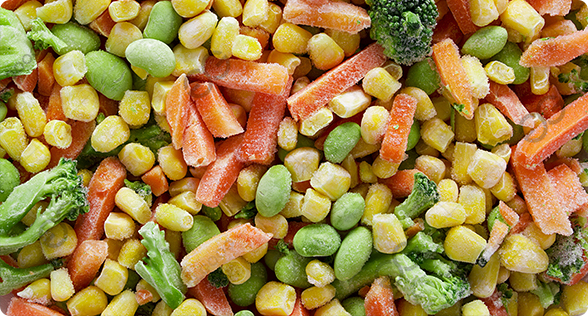IQF vegetables are fresh vegetables preserved through freezing technology. The processing process is complex and delicate to ensure the nutritional value and taste of the final product. But what is the IQF process of vegetables:

Step 1. Raw material selection and acceptance
Selection of raw materials: The quality of IQF vegetables depends largely on the quality of raw materials. Choose vegetables that are fresh, free from pests and diseases, and free from mechanical damage. Different vegetables have different optimal harvesting times, which need to be precisely mastered to ensure the best condition of the vegetables.
Receiving and inspection: Upon arrival at the processing plant, vegetables need to undergo rigorous inspection, including checks on appearance, weight and maturity to ensure compliance with processing standards.
Step 2. Cleaning
Initial washing: removes soil, impurities and surface contaminants. A combination of running water rinsing and bubble washing is often used to ensure that the surface of the vegetables is clean.
Secondary Wash: To more thoroughly remove pesticide and bacterial residues, a secondary wash may be performed using a food-grade sanitizer. This process requires strict control of time and concentration to ensure safety and no residue.
Step 3. Cutting and sorting
Cutting: According to the characteristics of different vegetables and market demand, appropriate cutting is carried out. For example, carrots are cut into dices, slices or strips, cauliflower is divided into small pieces, etc.
Sorting: Cut vegetables need to be picked and removed from parts that do not meet specifications, such as aged leaves or incomplete tubers.
Step 4. Blanching
Blanching is the process of heating vegetables in boiling water for a short period of time and then cooling them quickly. The main function of this step is to:
Kill microorganisms on the surface of the vegetables to prevent spoilage.
Brighten the color of the vegetables and maintain a good appearance.
Fix the nutrients of the vegetables to prevent loss during subsequent freezing.
Step 5. Cooling
Vegetables need to be cooled quickly after blanching, usually in ice water. This process quickly reduces the temperature of the vegetables and prevents overcooking due to continued heating after blanching.
Step 6. Drainage and pre-cooling
After cooling, vegetables need to be drained to remove excess water from the surface. This step helps to prevent the formation of excessive ice crystals during the freezing process, which may affect the quality of the vegetables.
Pre-cooling: Pre-cooling the vegetables to a temperature close to 0°C before formal freezing helps to shorten the final freezing time and increase the freezing efficiency.
Step 7. IQF
IQF is the most critical step in the entire process. IQF is usually carried out at temperatures between -30°C and -40°C to ensure that the vegetables pass through the zone of maximum ice crystal formation (0°C to -5°C) in the shortest possible time. Rapid freezing allows the formation of tiny ice crystals and avoids damaging the cellular structure, thus preserving the original texture and nutrient content of the vegetables.
Step 8. Packaging
IQF vegetables need to be packaged immediately, usually in vacuum or nitrogen-filled packaging to prevent oxidation and moisture loss. Packaging materials need to have good barrier properties to prevent the entry of outside air and moisture.
The processing process of frozen vegetables requires fine operation and strict control, and each step requires precision vegetable processing equipment to complete, if you want to know more about the processing process of frozen vegetables, you can left us a message.